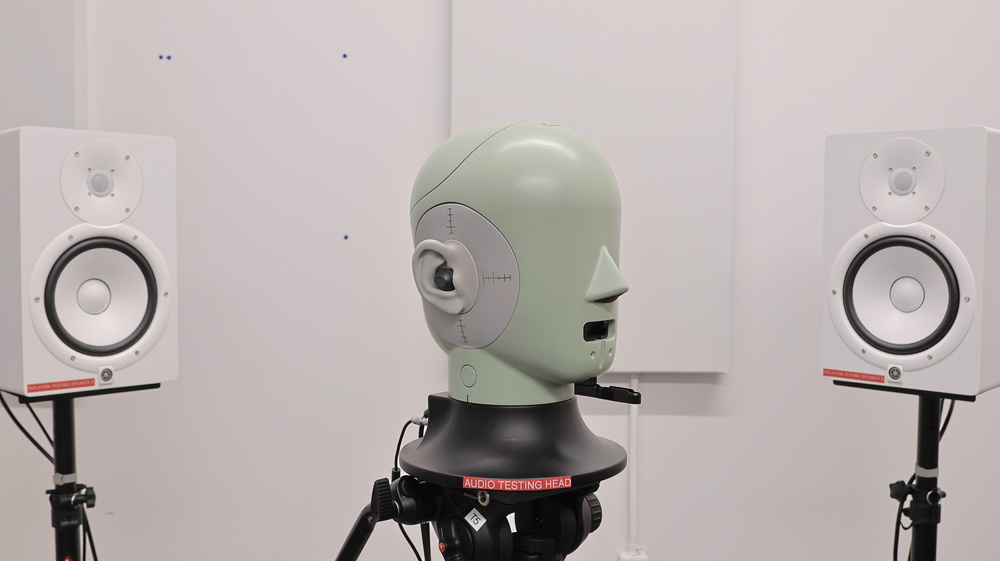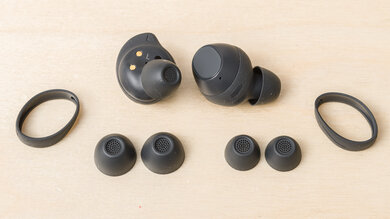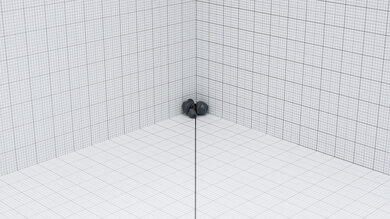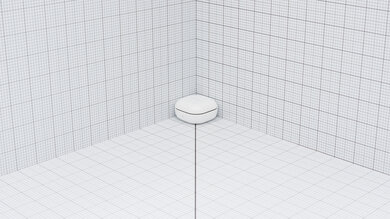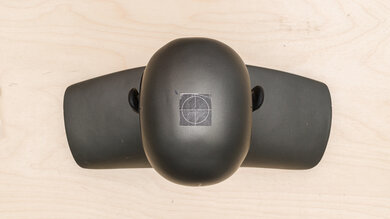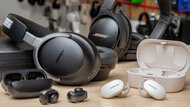The Samsung Galaxy Buds FE are budget-friendly noise cancelling (ANC) earbuds. They're more affordable than the Samsung Galaxy Buds2 but have fewer features than other models in the lineup, so you won't find head-tracking features or multi-device pairing. Still, you can expect Samsung's hallmarks, like solid noise cancelling, and Samsung-specific features like manufacturer-dependent codec support for streaming higher-quality audio.
Our Verdict
The Samsung Buds FE are very good for sports and fitness. Unlike other buds from Samsung, they have stability fins, which help keep them comfortable and in place during workouts. While they're also well-built, they're only rated IPX2 for resistance against light rain.
-
Stable in-ear fit and very comfortable.
-
Rated IPX2.
-
No volume controls by default.
The Samsung Buds FE are great for commuting and travel. These comfortable buds have noise cancelling and are well-suited for cutting down passenger chatter, the high-pitched hums of fans, and deeper-pitched noises like engines. With their ANC on, they last over six hours continuously, so if you need to top them up, their carrying case holds an extra 2.5 charges. They're also well-built and lightweight, making them easy to take with you on the go.
-
Excellent noise isolation performance.
-
Good overall microphone performance.
-
Stable in-ear fit and very comfortable.
-
Rated IPX2.
-
No multi-device pairing.
-
No volume controls by default.
The Samsung Buds FE are great for office use. They're comfortable, lightweight, and even equipped with excellent ANC, so you can easily block out chatty co-workers. Their over six-hour continuous battery life may not be enough to get you through your day, but their carrying case supplies roughly 2.5 additional charges. Unfortunately, they don't support multi-device pairing, but their microphone system does performs very well.
-
Excellent noise isolation performance.
-
Good overall microphone performance.
-
Stable in-ear fit and very comfortable.
-
No multi-device pairing.
-
No volume controls by default.
The Samsung Buds FE are Bluetooth-only headphones. They have high latency via SBC, which can cause delays between your audio and visuals. On the upside, if you're a mobile gamer on a Samsung device, you can benefit from their 'Game Mode,' which helps lower latency on these devices. But it won't work on other devices.
The Samsung Galaxy Buds FE are truly wireless earbuds; you can't use them wired.
The Samsung Galaxy Buds FE have decent audio reproduction accuracy. They're mainly let down by a few big peaks and dips in the treble range, which can render sounds like cymbals alternately dull or piercing. Otherwise, their left and right drivers are well-aligned in terms of phase and amplitude, and their great group delay performance ensures tight bass and transparent treble reproduction. These buds do have a warm sound, which many will appreciate, but fans of brighter headphones may wish to look elsewhere.
The Samsung Galaxy Buds FE have amazing noise isolation. They excel at cutting out higher-pitched sounds like workplace HVAC noise but also do an effective job minimizing the low rumbles of bus and train engines. If you're wearing these in an office, the sound of nearby conversations will be greatly reduced.
These buds have a good microphone system. While it doesn't capture much treble, meaning your voice lacks sparkle, it does a great job separating your voice from any noise around you, which could be handy if you're taking a call while on a busy street.
The Samsung Galaxy Buds FE are excellent when it comes to frequency response consistency. Once you achieve a solid fit with the right pair of ear tips, you'll experience consistent audio delivery. Our frequency response measurements will be reflective of their actual performance for the vast majority of people.
- 7.9 Sports And Fitness
- 8.0 Travel
- 8.0 Office Work
- 5.8 Wireless Gaming (In Development)
- 5.7 Wired Gaming (In Development)
Performance Usages
- 7.2 Audio Reproduction Accuracy
- 8.7 Noise Isolation
- 7.7 Microphone (In Development)
- 8.9 Frequency Response Consistency
Changelog
-
Updated Apr 29, 2025:
We've updated the review to list the correct number of charges supplied by the earbuds' case in the Battery box.
-
Updated Apr 25, 2025:
We've updated the Noise Isolation section of the review to reflect user-reported issues with the earbuds' ANC.
-
Updated Apr 25, 2025:
This review has been updated to Test Bench 2.0, which adds the following tests: Stereo Mismatch, Group Delay, Cumulative Spectral Decay, PRTF, Harmonic Distortion, and Electrical Aspects. We've added new performance usages and updated the text throughout the Sound tests and side-by-sides.
- Updated Apr 25, 2025: We've converted this review to Test Bench 2.0, which updates our sound tests and adds performance usages. You can read more about this in our changelog.
-
Updated Dec 06, 2024:
This review has been updated to compare their Noise Isolation - Full Range to the Samsung Galaxy Buds3 Pro Truly Wireless.
Check Price
Differences Between Sizes And Variants
The Samsung Galaxy Buds FE come in two color variants: 'Graphite' and 'White'. We tested the 'White' model; you can see their label here. If you encounter another variant of these buds, please let us know in the forums below.
Popular Headphones Comparisons
The Samsung Galaxy Buds FE are budget-friendly buds. They're on the lowest end of Samsung's price scale, and while they don't support features like 360 Audio for a more immersive sound, there are a couple of improvements over other buds in their lineup. They have a more comfortable fit than the Samsung Galaxy Buds2, thanks to their removable stability fins, which are handy if you want to use them at the gym during tough workouts. They also have a longer continuous battery life than other models in this lineup. That said, even though their ANC offers excellent overall performance, the Samsung Galaxy Buds2 Pro still cut out more low rumbles, while the Buds FE block more high-pitched noise.
Samsung's Galaxy series of earbuds tend to pair best with Android phones. If you're an iPhone user, the Apple AirPods 4 with Active Noise Cancellation are a solid alternative, although you do pay a bit more for the privilege of iOS-specific features like personalized volume and automatic ear detection. And if you're looking for a cross-platform alternative, the Nothing Ear (a) are a great pick. They have a balanced sound and support multi-device pairing, but their noise isolation and mic aren't as good as the Samsung's.
Check out our picks for the best wireless earbuds for Android, the best sounding wireless earbuds, and the best noise cancelling earbuds.
The Sony WF-C700N Truly Wireless and Samsung Galaxy Buds FE stand as value-driven options with noise cancelling features. The Sony headphones include a greater IPX4 rating against water, a longer continuous battery life, straightforward controls, and a virtual surround sound feature. They also have multi-pairing for up to two devices. However, their noise cancelling isn't as strong as the Samsung earbuds' ANC. The Samsung headphones also sound good but with a more rudimentary EQ. They include Samsung's proprietary adaptive codec for use with the brand's phones. Their built-in stability fins are great for ensuring a secure fit for some people's ears but aren't enough for everybody. They also have a lesser IPX2 rating and a shorter battery life to a single charge, but more charges stored in the case than the Sony model.
The Samsung Galaxy Buds2 have a couple of extra features over the Samsung Galaxy Buds FE. While both buds look somewhat similar, the Buds2 support 360 Audio, which is a head-tracking feature that can make for a more immersive audio experience. Both have effective noise cancelling. However, the FE model are more comfortable thanks to their stability fin design, and have a longer continuous battery life. Their microphone also offers a superior performance.
The Samsung Galaxy Buds2 Pro have a few more extra features than the Samsung Galaxy Buds FE. The Pro model have a higher IP rating for water resistance, comparable noise isolation, and a head-tracking feature, making for a more immersive audio experience. That said, the FE model are more comfortable, thanks to their stability fins, and have a better overall microphone performance. Their battery life is better, too.
The Samsung Galaxy Buds FE are better than the Samsung Galaxy Buds3. The FE have a better microphone and better ANC. They're also cheaper than the Buds3.
Choosing between the Nothing Ear (a) and the Samsung Galaxy Buds FE depends on how much you like to tweak your audio and which mobile device you own. The Nothing have nearly the same functionality regardless of your OS and a much more nuanced and comprehensive custom EQ. They also let you pair to two devices simultaneously. On the other hand, the Samsung's EQ presets are only accessible through the Android app, and their better quality codecs are exclusive to Samsung devices. That said, their mic, noise isolation, and battery life are a bit better than the Nothing's, but they can only connect to one device at a time.
The Samsung Galaxy Buds FE offer better overall performance than the Samsung Galaxy Buds Pro. The FE model are more comfortable, and their ANC can block out more ambient noise. They also have a longer continuous battery life and support Samsung's Scalable Codec, allowing you to stream higher-quality audio.
The Samsung Galaxy Buds FE are slightly better than the EarFun Air Pro 3 True Wireless. While both buds have effective noise isolation performance, the Samsung ANC is better overall and they're more comfortable. Their mic's overall performance is better, too. That said, the EarFun have a better battery performance, their companion app offers a graphic EQ for more fine-tuned control over your sound, and they support multi-device pairing.
The Samsung Galaxy Buds FE are much better headphones than the Beats Solo Buds. The Samsung have excellent ANC that blocks out way more sound than the ANC-less Beats. They also have a much better microphone and give you the option to adjust the sound via the EQ presets. On the other hand, the Beats have a better continuous battery life, and you can pair them to two devices at the same time (though you can't listen to audio from both devices simultaneously).
The Samsung Galaxy Buds FE offer great value for their retail price, but if you're willing to up your budget, the Jabra Elite 8 Active Gen 2 offer some considerable upgrades. They're slightly better built and more comfortable and stable in your ears. The Jabra headphones also offer better noise isolation performance and better mic recording quality. They come with Dolby Spatial Audio, which can add an immersive quality to your listening experience. Finally, the Jabra also come with a nifty 'smart case', which lets you connect wired audio sources via the USB-C port in the case, which then transmits audio via Bluetooth to the buds.
Video

We've upgraded our Headphones Test Bench to 2.0! This update brings several key changes to our tests and usages, making it easier than ever to interpret our sound results based on your personal preferences. You'll also find a brand-new interactive graph tool featuring multiple targets (including our own!) for you to explore and compare.
For a full breakdown, check out our changelog, which includes detailed commentary from our test designer explaining the rationale behind our update.
We'd also love to hear your thoughts: your feedback helps us keep improving, so join us in the comments!
Test Results
These buds have a warm sound profile. Their companion app comes with a few EQ presets that can help tailor the sound to your needs. The frequency response also changes based on whether the ANC is enabled, with a slight reduction in bass when the feature is disabled.
The frequency response consistency is amazing. You'll get a consistent sound with each wear once you get a good fit using the included ear tips and stability fins.
The Samsung Buds FE comply well with our bass range target. However, the whole range is somewhat overemphasized, particularly in the low and mid-bass. Consequently, the kicks in club-ready tracks like Darude's Sandstorm have plenty of thud and slam. Whether all that thump is a little overwhelming is a matter of taste, but bass heads will appreciate the rumble.
These headphones have remarkably compliance with our mid-range target. The response is pretty flat and neutral, so in songs like Mitski's My Love, Mine All Mine, her vocals and the soft instruments surrounding them are present, natural, and clear throughout the track.
The Samsung Galaxy Buds FE have excellent compliance with our treble range target. A bit of treble roll-off in the lower part of the range slightly reduces the upper harmonics of vocals, which can affect intelligibility. And a more significant dip in the response between the mid and high-treble can detract from the breathy brilliance of whispery vocals.
The peaks and dips performance of these buds is passable. Mostly, the response is pretty flat and neutral, especially through the bass and mid-range regions, which means that the headphones don't deviate much from their sound profile. However, the treble response is less well-managed, so sounds like cymbals are rendered dull or piercing depending on their pitch.
The left and right drivers are well matched in both amplitude and phase response. The biggest mismatch in frequency response occurs in the mid-treble region, so you might notice that a centrally-panned hi-hat sounds slightly off center. But, in truth, it's very hard to notice this discrepancy with regular content. The phase response mismatch also falls below the audibility threshold, ensuring kick drums feel punchy and cymbals are crisp and clear.
The Samsung Galaxy Buds FE have great group delay performance. The group delay falls below the audibility threshold, ensuring tight bass and transparent treble reproduction.
These earbuds bypass your outer ear by design, so they don't produce audio that interacts with your pinna.
The Samsung Galaxy Buds FE have outstanding distortion performance. They reproduce your audio clearly and cleanly.
These are truly wireless buds, they don't plug into an output port.
Unlike the Samsung Galaxy Buds2, these headphones don't support 360 Audio for a more spacious and immersive sound.
These are the settings used to test these headphones. Our results are only valid when used in this configuration.
The Samsung Buds FE look closer to buds produced by Jabra like the Jabra Elite 10 than to the Samsung Galaxy Buds2 Pro. Instead of a rounded bud shape, they have a flat surface that doubles as their controls. They come in a couple of different colors: 'Graphite' and 'White'.
These buds have a pretty comfortable fit. They rest nicely on the outer edge of your ear canal, so they don't need to be forced further into your ear. The buds themselves are a little bit smaller than the Samsung Galaxy Buds2 Pro, but they also have wingtips, which help keep them in place and feel very comfortable compared to their otherwise hard plastic edge. That said, their bud shape may not be the most comfortable for all users, depending on the shape of your ear. If you find an earbud-style fit gentler on your anatomy, consider the Samsung Galaxy Buds3.
These buds have very simple controls. There's a touch-sensitive surface on each bud, which is a little too responsive since you can easily register a command by accident. There are no volume controls by default either, which is a little disappointing. You can enable this feature by changing the 'Hold' option in the companion app. You'll lose out on other controls, though. There are chimes to let you know when you've reached min/max volume and when you play or pause audio or cycle between different ANC modes.
On either bud:
- One tap: Plays and pauses audio.
- Two taps: Skips the track forward.
- Three taps: Skips the track backward.
- Touch and hold for two seconds: Cycles through ANC on and ambient sound, which allows you to hear your environment without pausing your audio. You can add ANC off via the companion app though.
Their carrying case is good and is nearly the same as that of the Samsung Galaxy Buds2. The case is lightweight and has a glossy shell with a matte interior. There are LED lights to indicate the case's charging status as well as the buds' battery status. The hinge feels sturdy, too. Unfortunately, unlike the Samsung Galaxy Buds2 Pro, the carrying case doesn't support wireless charging.
The build quality of these buds is good. They're mostly made of plastic with silicone ear tips and stability fins, so they feel sturdy. The buds are also certified IPX2 for resistance against light rain, though this is less than the IPX7 of the Samsung Galaxy Buds2 Pro, which have protection against water submersion. Unfortunately, the silicone ear tips can rip if mishandled.
The Samsung Galaxy Buds FE's full-range noise isolation performance is impressive. Essentially, their already isolating fit, which handles high-pitched and mid-frequency noises effectively, is advantageous for setting the ANC up to cut out even more low-pitched environmental sounds. The ANC mainly handles the deep, low sounds of your surroundings and the midrange ambient din, though the Samsung Galaxy Buds3 Pro cut out more low-pitched noise. However, the mids aren't evenly reduced, which can give the impression of a relatively narrow span of frequencies poking through and reaching your ears. Still, not everyone will notice that, and it depends on your sensitivity. Their passive isolation is great, though, and they actually block trebly noises better than their successors, the Galaxy Buds3 Pro.
It's worth noting that we've had several user reports of white noise, hissing, and popping when either ANC or 'Ambient sound' is activated. No concrete fix has been found, so if you encounter the issue, consider returning them under warranty and grabbing an alternative with similarly solid noise isolation like the CMF Buds Pro 2.
In common scenarios, the combined ANC and passive isolation of the Samsung Galaxy Buds FE do an amazing job of cutting out audible distractions like the whoosh of cars in traffic and the HVAC at your workplace. Higher-pitched sounds, like dish clatter, are dampened the most comprehensively. Their ANC effectively reduces low engine rumbles from buses and people's chit-chat, comparable to the performance of the Samsung Galaxy Buds2 Pro.
These earbuds don't have a wind reduction mode to help reduce the popping sound of 'anti-noise' produced by the ANC system when air hits the microphones. That said, they perform better than their sibling, the Samsung Galaxy Buds2 Pro, although both are sensitive to the direction of the wind.
The Samsung Galaxy Buds FE have an outstanding leakage performance. Leakage is mostly concentrated in the bass range, which sounds full-bodied. However, overall leakage is very low, so if you're listening to your favorite tunes at a high volume, people around you won't hear it unless you're in a very quiet environment.
The integrated mic has a decent recording quality. There are slight differences in frequency response compared to the Samsung Galaxy Buds2 Pro, particularly in the treble range, which improves their high-frequency extension and, in turn, how bright and open your voice sounds. Overall, your voice is clear and intelligible.
The mic has a great noise handling performance. The mic can separate your voice from background noise quite well, so you're understandable, even in busy environments like a train station.
The Samsung Galaxy Buds FE have a mediocre battery performance. The manufacturer advertises that these buds last 8.5 hours with ANC off and six hours with ANC on. That's similar to the over six hours we measured with ANC on. Battery life varies depending on use, though, and volume and features like voice call can impact battery life. The carrying case holds 2.5 additional charges if needed, and you can even use one bud while the other charges. If you're looking for better continuous battery life, earbuds like the Beats Solo Buds run for much longer between charges.
The Galaxy Wearable app is good. However, it's unavailable on iOS devices, so you can't adjust your headphones' settings to your liking unless you use an Android device. There are features like EQ presets, an earbud fit test, and a 'Game Mode,' which lowers latency on Samsung devices. You can customize your control layout and manage features like ANC and in-ear detection. You can see a video of how it works here. The manufacturer added live AI translation in a subsequent update, but you need a Samsung account and a compatible phone by the brand, such as a Samsung Galaxy S24 or newer. If you want to sidestep too many brand-exclusive features, you can consider the Nothing Ear (a), which offers most of the same support across operating systems, plus greater EQ customization.
These buds have good Bluetooth connectivity. While they don't support multi-device pairing, they have some unique features for Samsung devices. They have a 'Game Mode,' which considerably lowers latency on Samsung devices so that you can game with minimal lip sync issues. They also support the brand's proprietary codec, the Samsung Scalable Codec (SSC), intended to yield higher quality audio while adjusting for factors like connection strength by changing the bitrate, which, like 'Game Mode,' requires a compatible Samsung device. That said, they otherwise only support AAC and SBC codecs. Their latency via SBC is quite high, and you'll experience a delay between your audio and visuals. Some apps and devices compensate for latency, though.
These headphones can only connect to Bluetooth-enabled PCs. On the upside, you'll have full audio and mic compatibility.
These headphones come with a carrying case that holds roughly 2.5 extra charges. There's a USB-C port for recharging the case. However, unlike the Samsung Galaxy Buds2, the case doesn't support wireless charging.
Comments
Samsung Galaxy Buds FE: Main Discussion
Let us know why you want us to review the product here, or encourage others to vote for this product.
- 21010
the microphone ratings are not accurate. i ordered these based on these ratings after everyone complained about my buds+. after i got these , everyone still complained about the sound. i switched to oneplus buds 3 (which has a lower rating) and its a night and day difference according to what everyone tells me.
- 21010
In my case, the fins are too small. They go past my antihelix without hooking into it, and so they aren’t held in place. They might as well not be there at all. I guess they aren’t an option for large ears, though I wasn’t aware that I have particularly large ears to begin with. There is no bigger fin/wingtip available.
Edited 1 month ago: better wording: touching -> hooking into. Mention that there is no bigger fin/wingtip available. - 43230
Can it be possible to measure the frequency response of the Clear EQ preset? How does it look on the graph? Will neutrality be increased with the preset? As the test conducted by SoundGuys, the Clear EQ preset better aligns the earbuds to their harman target.
Hi Ronalyn,
Thank you for reaching out. As you pointed out, using the Clear EQ, the Frequency Response will follow the SoundGuys Headphones Preference Curve a lot closer. Here is the link to all the EQ Presets offered by the Galaxy Buds FE.Link
Cheers, Dagobiet
- 21010
Can it be possible to measure the frequency response of the Clear EQ preset? How does it look on the graph? Will neutrality be increased with the preset?
As the test conducted by SoundGuys, the Clear EQ preset better aligns the earbuds to their harman target.
Update: We’ve updated the review to list the correct number of charges supplied by the earbuds’ case in the Battery box.

